Food
What are the Essential Vitamins and Minerals?
Understanding how the 27 vitamins and minerals are used in the body is essential when you want to change your diet. Knowing what you need instead of just a list of food or a diet plan is better because you will know how the micronutrients affect your body.

Vitamin A – Deficiency can lead to blindness or night blindness. Vitamin A is important for growing children and expectant mothers.
Vitamin B6 – It is essential in the formation of hemoglobin by storing protein and carbohydrates and using iodine.
Vitamin B12 – It helps get the energy from food, make healthy red blood cells, and maintains a healthy nervous system.

Vitamin C – It helps make collagen and is considered an antioxidant. Deficiency can lead to scurvy.
Vitamin D – It helps regulate the calcium and phosphate levels in the body. Deficiency can lead to osteomalacia, rickets, and body pain.
Vitamin E – It serves an as antioxidant that maintains healthy skin, eyes, and immune system.
Vitamin K – Deficiency can make wound healing slow and difficult, because not only does it keeps bones healthy but it’s important for blood-clotting.

Biotin – It is used for fat metabolism.
Calcium – It’s the important component for bones and teeth. Deficiency can cause poor mobility, brittle bones, and degeneration.
Choline – This is needed in muscle control and memory because it is used for the production of acetylcholine, a neurotransmitter.

Chromium – It affects both the energy we get from food and the insulin levels in the body.
Copper – It is essential in the release of iron during hemoglobin-formation. It’s also important in white blood cell production.
Folate – It helps in the formation of red blood cells. In pregnant women, folate is necessary for the infant’s nervous system development.
Iodine – Its most important function is during the synthesis of thyroid hormones.

Iron – Its most important function is the creation of red blood cells to carry oxygen.
Magnesium – It is essential in converting food into energy, hormone production, and bone health.
Manganese – It’s important in activating body enzymes.
Molybdenum – It helps in activating enzymes for creating genetic material.
Niacin – It helps in getting the energy from the food as well as maintain healthy skin and nervous system.

Pantothenic Acid – Without pantothenic acid, you will always feel tired and stressed. It helps in several bodily functions especially in releasing the energy from food.
Phosphorus – Not only does it help release energy from food, it also helps maintain strong bones and teeth.
Potassium – It helps in maintaining healthy nerves and muscles, as well as keep the heart muscles healthy and balancing the body fluids.
Selenium – It’s an antioxidant that helps the immune system prevent damage to cells and tissues.

Sodium and Chloride – These are electrolytes that maintain the balance of body fluids. They even help the body digest the food we eat.
Thiamin – This is needed to convert carbohydrates to energy, as well as maintain proper nerve signal conduction and muscle contraction.
Riboflavin – It helps in releasing the energy from food and keeps the nervous system, skin, and eyes healthy.
Zinc – It helps in the processing of protein, fat, and carbohydrates, as well as in keeping healthy cells, making enzymes, and healing wounds.
Singapore Soul Food
One of the most frequently asked questions when it comes to travel is “How is the food?” You probably already know about the history of Singapore but if you don’t, well, Singapore’s economic success comes from trade.

Way back in the age of exploration, Singapore used to be a place where the British, Chinese, Malaysians, and many other countries would conduct business and naturally, Singapore started to grow economically. The cultural influence of these many countries has affected the taste of Singaporeans. Because of trade, Singapore has picked up a very unique taste which involves western and south-east cuisines.
Most restaurants in Singapore actually serve dishes from all around the world and if you are looking for that specific Singaporean taste, the best thing to do is to go to the “hawkers”. These are establishments built like cafeterias and although the simplicity might fool you, these “hawkers” serve really good Singaporean dishes. One of the best dishes to try is the Hainanese Chicken Rice.

One magical thing about the Hainanese Chicken Rice is actually the rice itself. The rice is cooked in chicken broth and many other ingredients we do not want to spoil you with but they are what make the rice stand out with its distinct flavor.
The Hainanese Chicken Rice is just one of the dishes you have to try in Singapore as there are countless choices to pick from. Another good thing about the Hawkers is that they are very affordable, their dishes do not usually go beyond 15 Singaporean dollars.
One little-known fact about Singapore is that most of the influences when it comes to food comes from Hong Kong. The good thing about Singapore is the diverse mix of different cultures which definitely have something new to offer to the table. The quality of these diverse dishes are also exquisite as chefs from all over the world can be found in Singapore.

The quality of the food in Singapore is exquisite as everything in Singapore is exported and since they are involved in the trade industry, they make sure that the quality of the food that both go in and go out of the country are at top quality.
There isn’t much to worry about when it comes to buying ingredients as almost everything is available. Singapore is also a big fan of organic products which is really good should you want to pursue healthy living. Finding soul food in Singapore is easy as almost every dish is crafted with excellence.
A Quick Beginner’s Guide to Meal Prepping
Whether you’re working towards a healthier lifestyle or simply looking to cut down costs, planning your meals gives you more control over what you eat.
This lets you actively build a meal with the right amount of calories and nutrients instead of basing it around what’s easy and convenient – and the best part about it is that it doesn’t have to be as expensive as you would think.
Meal planning is great for everyone, but it works especially well for those who are on a tight schedule. Depending on how far you plan, you can save yourself the time and money from several days, and even up to a week.
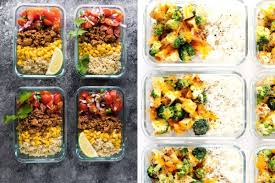
To do that, these are the steps you need to follow:
1. Grab a meal-planning sheet or any sheet of paper.
Start jotting down your plans for meals by writing down the days of the week that you plan on preparing your meals for. If you find that a few days or so will be particularly hectic, plan meals that don’t take up too much time to make.
With meal prepping, you can also focus less on breakfast and lunch, and more on dinner, especially if you have a hectic schedule.
2. Take a look at your weekly schedule.
Ask yourself for any upcoming plans in the week, and then proceed to plan around that. You also don’t need to plan more than two weeks at a time, especially if you’re just starting out.
In fact, the simplest way you can start meal prepping is by doing so a few days at a time. This lets you find your rhythm and your schedule, and what kind of meals you enjoy best.
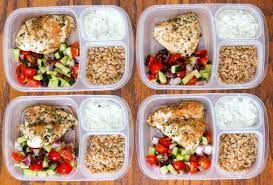
3. Choose meals that are easy to prepare.
Aside from taking up a lot of time, complex meals also use a lot of ingredients, and you’ll end up spending more for them. You should also look into the ingredients in terms of volume.
One advantage to meal prepping is that because you’re buying ingredients in bulk, you get to save more money than you would otherwise spend on eating out.
4. List the ingredients you need to prepare the meals on a separate sheet of paper.
This will be the grocery list you’ll be sticking to when you need to buy the ingredients for your meals. It also helps if you don’t throw your lists away, but save them instead for when you prep for more than one time.
And don’t forget to include the seasoning!
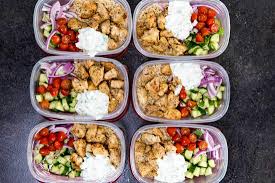
5. Prepare the containers needed for each meal.
Whether it’s simple plastic bags or full containers with a lid, the important thing is that it’s enough for the meal in question and that there’s enough space in your refrigerator.
If there aren’t enough small containers for every meal, you can simply place the food in one large container and take small portions out of it to reheat when you need it.
Common Herbs and Spices
We usually focus on the meat or vegetables in our meals. Take a look at some of the most commonly used herbs and spices that give flavors to our food.
Allspice is the harvested unripe berries of a tree. It’s also called myrtle or Jamaican pepper, newspice or yenibahar.
Anise or Aniseed is valued for its seed which is harvested fresh or ground. It’s also used for tea, liquor, and medicine.
Basil has many varieties but the most commonly used are sweet or Genovese, lemon, Thai, African blue, and holy basil. The seeds are also used in desserts and drinks.
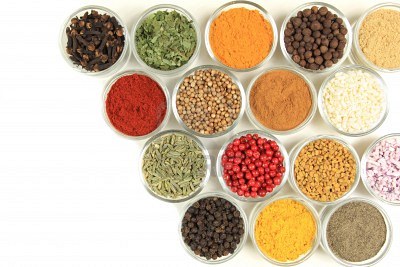
Bay Leaves come from different aromatic plants such as bay laurel, West Indian, Indian, California, Indonesia and Mexican bay leaf.
Black Pepper is a dried and cooked unripe fruit of a flowering vine. The dried fruit is called peppercorn. Green peppers are the dried unripe fruit, while white peppers are the ripe fruit seeds.
Cardamom comes from the seeds of the Amomum and Elettaria. It’s also used in drinks and harvested for its essential oil.
Cayenne Pepper comes from the fruit of a plant related to paprika, bell pepper and jalapeno. The fruits are dried, ground, or used fresh or as flakes.
Cilantro or Coriander is an herb cultivated for its seeds, fruits and leaves, but the whole plant itself is edible.

Cinnamon may be ground or sold in sticks. They are taken from the bark of Cinnamomum trees. Common types of cinnamon are Indian, Malabar, Chinese, Vietnamese, Ceylon and Indonesian.
Cumin is valued for its seed which may be used as whole seeds or ground. It’s from a plant native to South Asia and the Mediterranean.
Salt is a mineral made up of sodium chloride. It’s taken from evaporated seawater, spring waters and salt mines.
Garlic may be used fresh or ground. The bulb of the garlic plant is divided into smaller sections called cloves. Its flowers and leaves are also edible.
Ginger has a rhizome used as spice and ground or used fresh. Similar plants such as the galangal or krachai and wild ginger also produce the same aroma.
Marjoram is an herb valued for its aromatic leaves which are harvested green or dried. They are also distilled for oils.
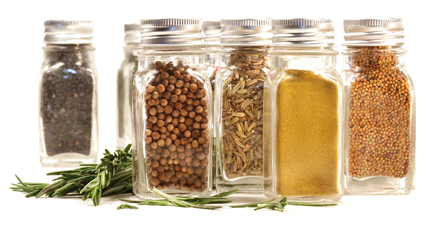
Onion has a part called the bulb. The plant, called spring onion or scallion, can be harvested while still young. Onions come in three colors; brown or yellow, white and red.
Oregano is a flowering plant. Its leaves are dried and sometimes extracted for its oil.
Paprika is a mix of red air-dried fruits of the bell pepper and sweet pepper. Other spices are also included.
Parsley is a flowering plant used as a vegetable, spice and herb. The most common types of parsley are leaf and root parsley.
Rosemary is an herb also used as a decoration. Its leaves are harvested fresh or dried for cooked dishes or tea.
Thyme is sold by sprigs (or a single stem with leaves and flowers) or dried. It is also harvested for its oil.
Turmeric is an herbaceous plant harvested for its rhizomes. They are used fresh, boiled and dried or ground.
